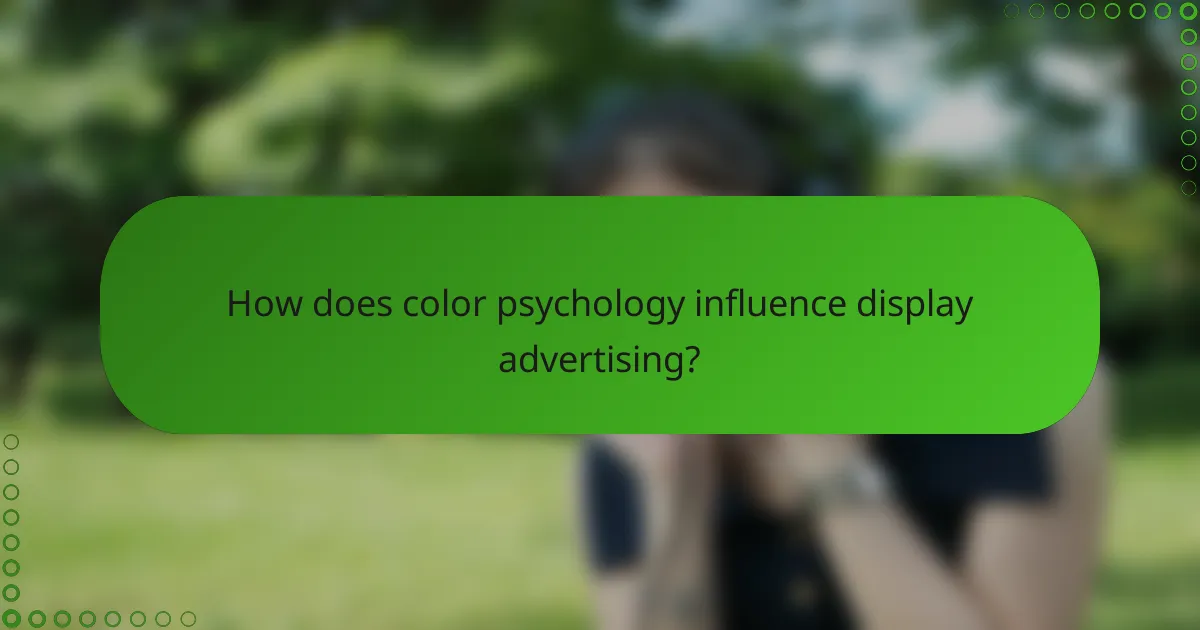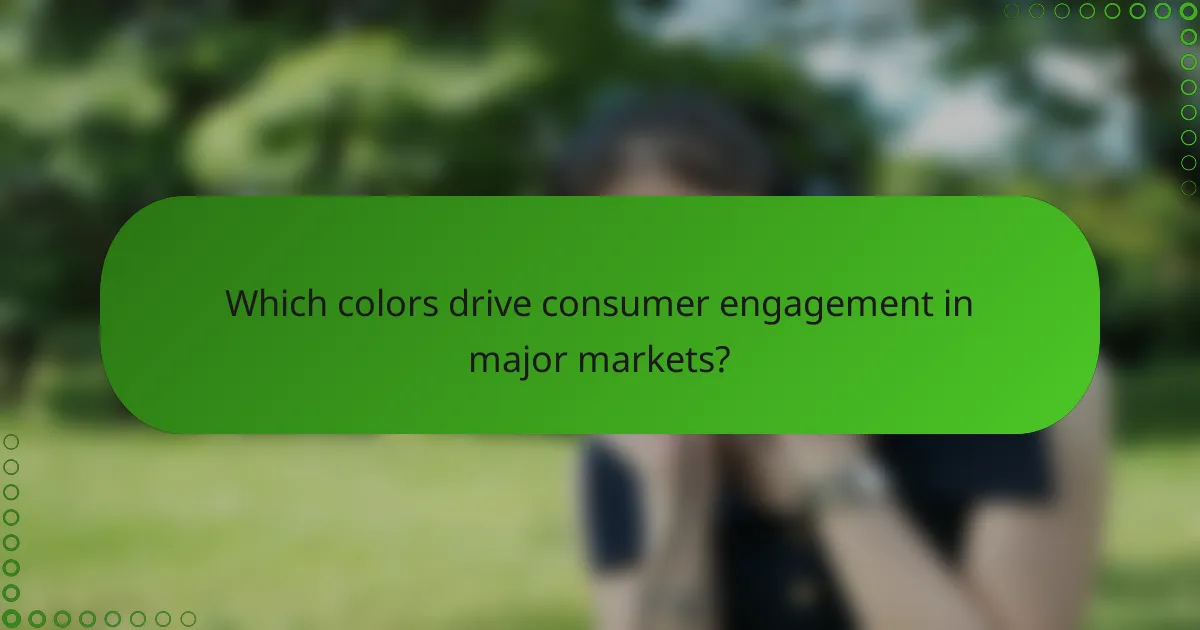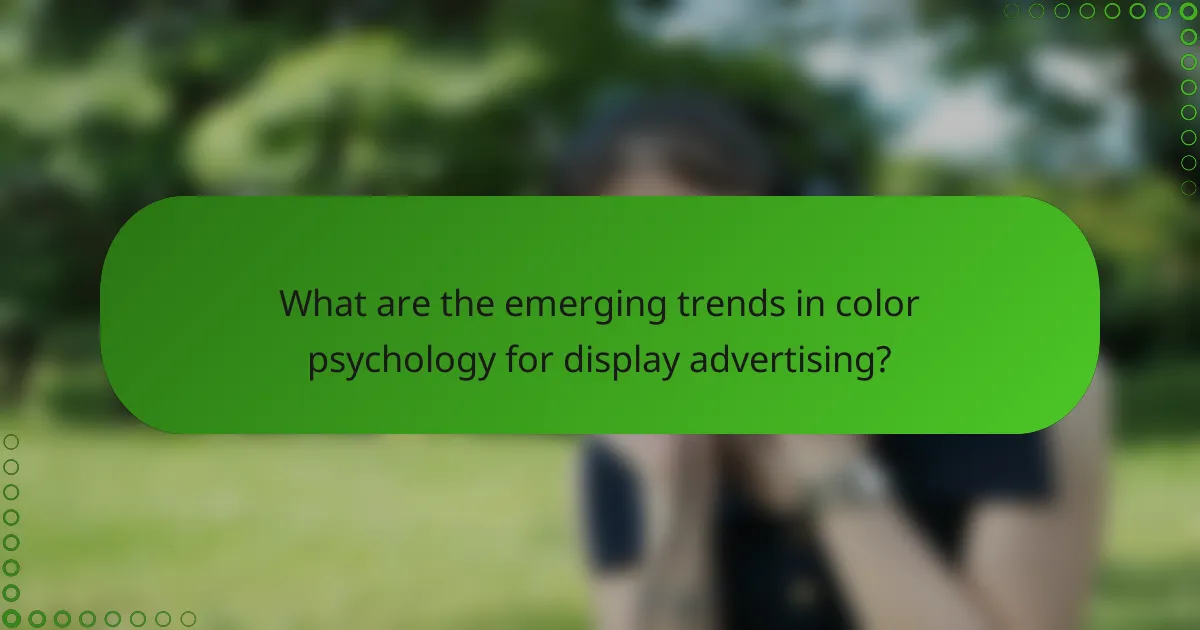Color psychology plays a vital role in display advertising by influencing consumer perceptions and emotional responses. By strategically selecting colors that align with a brand’s message and target audience, advertisers can enhance engagement and improve the effectiveness of their campaigns.

How does color psychology influence display advertising?
Color psychology significantly impacts display advertising by shaping consumer perceptions and emotional responses. Different colors can evoke specific feelings and associations, which can influence how a brand is perceived and the effectiveness of its advertising campaigns.
Emotional responses to colors
Colors trigger various emotional responses that can affect consumer attitudes. For instance, red often evokes excitement and urgency, making it effective for clearance sales, while blue tends to create a sense of trust and calm, suitable for financial institutions.
Understanding these emotional triggers allows advertisers to select colors that align with their brand message and the desired consumer reaction. For example, green is frequently associated with health and tranquility, making it a popular choice for eco-friendly products.
Color associations with brands
Many brands leverage color associations to establish their identity and differentiate themselves in the market. For example, Coca-Cola’s red is synonymous with energy and passion, while Tiffany & Co.’s signature blue represents luxury and exclusivity.
These color associations can enhance brand recognition and loyalty. Consistent use of specific colors across marketing materials reinforces the brand’s image and helps consumers quickly identify products in a crowded marketplace.
Impact on consumer behavior
Color choices in display advertising can significantly influence consumer behavior, including click-through rates and purchase decisions. Studies suggest that up to 90% of snap judgments about products can be based on color alone.
Advertisers should consider using contrasting colors to highlight calls to action, making them stand out and encouraging engagement. Additionally, testing different color schemes can help determine which combinations resonate best with target audiences, optimizing campaign effectiveness.

What are effective color strategies for display ads?
Effective color strategies for display ads involve selecting hues that not only catch the eye but also resonate with the brand’s message and target audience. By understanding color psychology, advertisers can enhance consumer engagement and drive better responses.
Color combinations that attract attention
Using contrasting color combinations can significantly enhance visibility and draw attention to key elements in display ads. For instance, pairing a bright color like yellow with a dark color like black creates a striking visual effect that can capture the viewer’s interest quickly.
Consider using complementary colors, which are opposite each other on the color wheel, as they naturally attract the eye. Examples include blue and orange or red and green. These combinations can create a dynamic look that encourages interaction.
Using color to convey brand identity
Colors play a crucial role in establishing and communicating brand identity. For example, blue often conveys trust and reliability, making it popular among financial institutions, while green is associated with health and eco-friendliness, appealing to environmentally conscious consumers.
When developing display ads, ensure that the chosen colors align with the overall brand palette. Consistency in color usage helps reinforce brand recognition and fosters a sense of familiarity among consumers.
Case studies of successful color use
One notable case is Coca-Cola, which effectively uses red to evoke feelings of excitement and energy, aligning with its brand message of enjoyment. This color choice has contributed to its strong brand recognition worldwide.
Another example is Starbucks, which utilizes green to symbolize growth and sustainability, reflecting its commitment to ethical sourcing. This strategic use of color not only enhances brand identity but also resonates with its target audience’s values.

Which colors drive consumer engagement in major markets?
Colors play a crucial role in driving consumer engagement across major markets by influencing emotions and perceptions. Understanding which colors resonate with target audiences can significantly enhance brand impact and advertising effectiveness.
Popular colors in North American advertising
In North America, blue is often favored for its association with trust and reliability, making it a common choice for financial institutions and tech companies. Red, representing excitement and urgency, is frequently used in sales promotions and fast-food branding. Green is also popular, particularly among brands promoting sustainability and health.
Marketers should consider using these colors strategically to align with brand values and consumer expectations. For instance, a financial service might benefit from a blue palette, while a health food brand could effectively use green to emphasize its organic offerings.
Color preferences in European markets
European consumers exhibit diverse color preferences influenced by cultural contexts. For example, blue remains popular across many countries, symbolizing trust, while red may evoke different meanings, such as love in some cultures and danger in others. Additionally, colors like yellow and orange are often associated with optimism and creativity, appealing to younger demographics.
Brands should tailor their color choices to reflect local cultural nuances. A campaign in Germany might use more subdued tones to convey professionalism, while a campaign in Spain could leverage vibrant colors to attract attention and convey energy.
Regional variations in color perception
Color perception can vary significantly between regions, affecting how consumers respond to advertising. For instance, while white is often associated with purity in Western cultures, it can symbolize mourning in some Asian cultures. This discrepancy can lead to misunderstandings if brands do not consider local interpretations.
To navigate these variations, brands should conduct market research to understand regional color associations. Testing different color schemes in focus groups can provide insights into consumer reactions and help avoid potential pitfalls in cross-cultural marketing efforts.

How can brands measure the impact of color in their ads?
Brands can measure the impact of color in their ads through various methods, including A/B testing, consumer surveys, and analytics tools. These approaches help determine how different colors influence consumer perceptions and behaviors, ultimately affecting brand performance.
Tools for A/B testing color effectiveness
A/B testing is a powerful method for evaluating color effectiveness in advertising. Brands can create two versions of an ad—one with the original color scheme and another with a different color palette—and then measure performance metrics such as click-through rates and conversion rates.
Popular tools for A/B testing include Google Optimize, Optimizely, and VWO. These platforms allow brands to easily set up experiments and analyze results, helping to identify which color combinations resonate best with their target audience.
Analyzing consumer feedback on color choices
Gathering consumer feedback is essential for understanding color preferences. Surveys and focus groups can provide insights into how consumers perceive different colors and their emotional responses to them. This qualitative data can guide brands in making informed color choices for their advertising campaigns.
Additionally, social media platforms and online reviews can serve as valuable sources of consumer feedback. Brands should monitor comments and discussions related to their ads to gauge public sentiment about color usage and adjust their strategies accordingly.

What are the prerequisites for implementing color psychology in advertising?
To effectively implement color psychology in advertising, it’s essential to understand your target audience and the specific color trends within your industry. This foundational knowledge helps in selecting colors that resonate with consumers and enhance brand perception.
Understanding target audience demographics
Identifying the demographics of your target audience is crucial for tailoring color choices in advertising. Factors such as age, gender, cultural background, and socioeconomic status influence color preferences and perceptions. For instance, younger audiences may respond positively to vibrant colors, while older consumers might prefer more muted tones.
Conducting surveys or focus groups can provide insights into the color preferences of your audience. Additionally, analyzing existing customer data can reveal trends that inform your color strategy, ensuring it aligns with consumer expectations and enhances engagement.
Researching color trends in the industry
Staying updated on color trends within your industry is vital for maintaining relevance and appeal. Different sectors often have established color associations; for example, blue is commonly used in finance for its connotations of trust and stability, while green is prevalent in health and wellness for its associations with nature and vitality.
Regularly reviewing industry reports, competitor advertising, and consumer feedback can help identify emerging color trends. Utilizing tools like color trend forecasting websites can also provide valuable insights into which colors are gaining popularity, allowing you to adapt your advertising strategy accordingly.

What are the emerging trends in color psychology for display advertising?
Emerging trends in color psychology for display advertising highlight the growing importance of color in influencing consumer behavior and brand perception. Advertisers are increasingly leveraging color to evoke specific emotions and drive engagement, tailoring their color choices to resonate with target audiences.
Influence of digital media on color choices
Digital media has significantly shaped color choices in advertising, as brands adapt to the visual preferences of online consumers. The rise of social media platforms and mobile devices has led to a preference for vibrant, eye-catching colors that stand out in crowded feeds.
Moreover, the accessibility of design tools allows brands to experiment with color combinations quickly. A/B testing different color schemes can reveal which hues generate higher click-through rates and conversions, helping brands refine their visual strategies.
For instance, brands targeting younger demographics might opt for bold, saturated colors, while those appealing to more mature audiences may choose softer, muted tones. Understanding the target audience’s preferences is crucial for effective color selection in digital advertising.








